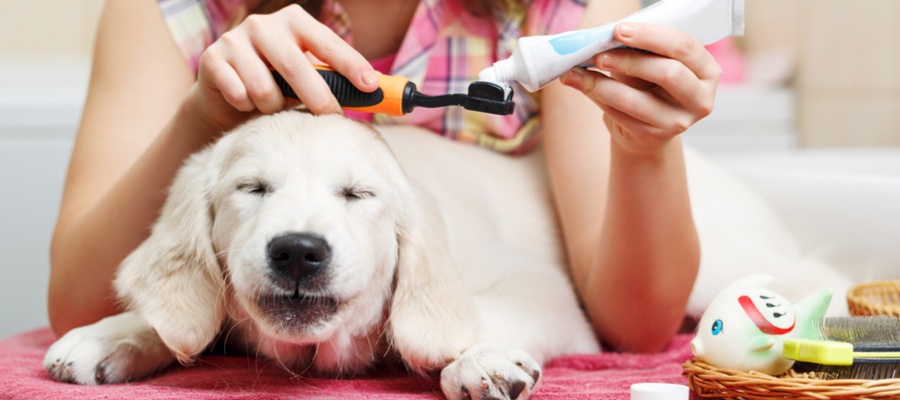Do you break out in a cold sweat just imagining brushing Fido's teeth? It's understandable, especially when you catch a glimpse of those needle-sharp canines and inscisors—even on your friendly dog, they can look pretty ferocious.
But daily brushing and dental care for dogs is essential to their long-term health. Just like humans, dogs need daily brushing and regular dental cleaning to stay healthy. A dog's teeth can cause all kinds of problems if their humans don't help them maintain them, from gingivitis and painful dental diseases to infections and difficulty eating. Rover's bad breath won't be the only consequence of neglecting a daily tooth-brushing regimen; eventually, tooth decay could cause severe disease, particularly in elderly dogs, and even cause life-threatening conditions. Your best bet to keep your pup in the clear is starting a daily brushing routine when they're young—or today, if they're not young anymore—and keep at it. With persistence and a little practice, you'll both be pros in no time.
How to Develop a Daily Teeth-Brushing Habit for Your Dog
Before you start, it's important to identify a good time to brush your dog's teeth. The minute you walk in the door from work at the end of the day probably won't be the best time, for instance, since your dog will be excited and jumpy and unable to sit still. Find a calm moment when your dog is relaxed. If possible, make brushing your dog's teeth something you do every day around the same time to keep you consistent. Many owners choose to brush their dog's teeth after their daily walk.
Once you've chosen the right time, follow these steps:
- Choose the right tools: You won't be able to walk to your cupboard and use a human toothbrush and toothpaste to get this job done. In fact, human toothpaste can be toxic to your dog's digestive system. Instead, purchase a brush with the help of a vet and pick up some dog-friendly toothpaste.
- Get your dog in the right position: Be sure you're not beginning this exercise by making your dog uncomfortable or anxious. Don't hold her down or catch her suddenly. Instead, kneel next to your dog or try putting him on your lap if he's small enough. If your dog starts fighting back, stop and instead just offer a sniff of the toothpaste and toothbrush. Try again later. It's important not to develop an unpleasant association with brushing in your dog's mind.
- Practice: The first few times you begin your brushing routine, start by practicing by pulling your dog's lips up and rubbing her gums and teeth with your finger. Try this for a few days in a row before moving on to brushing.
- Add toothpaste: Once your dog has begun to seem comfortable with you using your fingers to brush her gums and teeth, add the toothpaste. This toothpaste will likely be flavored like something your dog enjoys, so she'll see it as a treat. If he rejects the toothpaste, try a different flavor and find one he likes.
- Add the toothbrush: Now it's time to try the real deal. Go slowly, pulling your dog's lips away from both the bottom and top teeth and running the bristles in circular motions along the teeth and gumline. Don't forget to brush gums, as well, but be careful not to irritate them with too much contact. You may notice some slight bleeding when you brush, which is normal. If you see substantial or consistent bleeding, this could be a sign of gum disease. Talk to your vet.
- Make it a habit: Once your dog has learned toothbrushing can be a pleasant experience, you'll want to do it every day to maintain dental health.
Bring your pup in for a dental cleaning. Contact us today to learn more.

